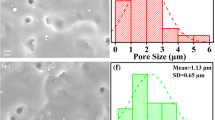Abstract
This paper presents a detailed investigation of the effect of a diode laser-induced thermal process on the hydrogen passivation of boron–oxygen (B–O) defects using numerical modelling. A state-of-the-art numerical model is developed using OpenFOAM based on a finite volume approach. The model considered dissociation, formation and passivation of the B–O defects including four reaction kinetics, and solved the coupled thermal equations and kinetic models. The developed model is then applied to elucidate the influence of passivation, as well as the formation of a B–O defect complex using laser-induced thermal phenomena by varying the key parameters of laser power and exposure time. The results reveal some interesting insights on how the hydrogen evolves out of the B–O defect sites, in the form of dissociation, when the exposure time is higher than 20 s, and hence affect the hydrogenated defect passivation process.
Similar content being viewed by others
References
S.H. Lee, M.F. Bhopal, D.W. Lee, and S.H. Lee, Mater. Sci. Semicond. Process. 79, 66 (2018).
P. Santos, J. Coutinho, and S. Oberg, Mater. Sci. Semicond. Process. 123, 1 (2018).
S.R. Wenham, C.B. Honsberg, and M.A. Green, Sol. Energy Mater. Sol. Cells 34, 101 (1994).
A. Wenham, L. Song, M. Abbott, I. Zafirovska, S. Wang, B. Hallam, C. Chan, A. Barnett, and S. Wenham, Front. Energy 11, 60 (2017).
Z. Wang, L. Zhang, S. Shi, P. Zhang, X. Cao, and B. Wang, J. Electron. Mater. 45, 5064 (2016).
T. Basu, M. Ray, N.R. Bandyopadhay, A.K. Pramanik, and S.M. Hossain, J. Electron. Mater. 42, 403 (2013).
P.N. Vinod, J. Electron. Mater. 42, 29052909 (2013).
D. Chen, P.G. Hamer, M. Kim, T.H. Fung, G.B. Sicotte, S. Liu, C.E. Chan, A. Ciesla, R. Chen, M.D. Abbott, B.J. Hallam, and S.R. Wenham, Sol. Energy Mater. Sol. Cells 185, 174 (2018).
V. Yelundur, A. Rohatgi, J.W. Jeong, A.M. Gabor, J.I. Hanoka, and R.L. Wallace, Proceedings of the 28th IEEE Photovoltaic Specialists Conference 91–94 (2000).
A. Rohatgi and J.W. Jeong, Appl. Phys. Lett. 82, 224 (2003).
A. Rohatgi, V. Yelundur, J. Jeong, A. Ebong, M.D. Rosenblum, and J.I. Hanoka, Sol. Energy Mater. Sol. Cells 74, 117 (2002).
B. Hallam, P. Hamer, S. Wenham, M. Abbott, A. Sugianto, A. Wenham, and C. Chan, IEEE J. Photovolt. 4, 88 (2004).
B. Hallam, D. Chen, M. Kim, B. Stefani, B. Hoex, M. Abbott, and S. Wenham, Phys. Status Solidi A 1700305, 1 (2017).
B. Hallam, M. Abott, N. Nampalli, P. Hammer, and S. Wenham, J. Appl. Phys. 119, 1 (2016).
P. Hamer, B. Hallam, R.S. Bonilla, P.P. Altermatt, P. Wilshaw, and S. Wenham, J. Appl. Phys. 123, 1 (2018).
P. Hamer, C. Chan, R.S. Bonilla, B. Hallam, G.B. Sicotte, K.A. Collett, S. Wenham, and P.R. Wilshaw, Sol. Energy Mater. Sol. Cells 184, 91 (2018).
M. Stavola, F. Jiang, A. Rhotagi, J. Holt, H. Atwater, and J. Kalejs, 3 rd World Conference on Photovoltaic Energy Conversion, Osaka, Japan (2003).
G. Hahn and A. Schonecker, J. Appl. Phys. Condensed Matter 16, 16151648 (2004).
C.M. Chong, S. Wenham, J. Ji, L. Mai, S. Wang, B. Hallam, and H. Li, Int. J. Photoenergy 2018, 1 (2018).
M.S. Ahmmed, L. Song, and N. Huda, Phys. Status Solidi A 201800060, 1 (2018).
L. Song, X. Zheng, J. Fu, and Z. Ji, J. Alloys Compd. 698, 892 (2017).
L. Song, A. Wenham, S. Wang, P. Hamer, M.S. Ahmmed, B. Hallam, L. Mai, M. Abbott, E.R. Hawkes, C. Chong, and S. Wenham, Int. J Photoenergy 193892, 1 (2015).
L. Song, L. Mai, and S. Wenham, Sol. Energy 122, 341346 (2015).
L. Song, Appl. Phys. A 122, 930 (2016).
L. Song, A. Wenham, and S. Wenham, Sol. Energy Mater. Sol. Cells 149, 221225 (2016).
L. Song, J. Wilson, and J. Lee, J. Phys. D Appl. Phys. 49, 315601 (2016).
F. Jiang, M. Stavola, A. Rohatgi, D. Kim, J. Holt, H. Atwater, and J. Kalejs, Appl. Phys. Lett. 83, 931 (2003).
R. Wood and G. Geist, Phys. Rev. B: Condens. Matter 34, 26062619 (1986).
M.A. Green, Sol. Energy Mater. Sol. Cells 92, 1305 (2008).
N.M. Ravindra, K. Ravindra, S. Mahendra, B. Sopori, and A.T. Fiory, J. Electron. Mater. 32, 1052 (2003).
B. Sopori, W. Chen, J. Madjdpour, and N.M. Ravindra, J. Electron. Mater. 28, 1385 (1999).
T.T. Rantala and J. Levoska, J. Appl. Phys. 65, 4475 (1989).
H.W. Lo and A. Compaan, J. Appl. Phys. 51, 1565 (1980).
Acknowledgments
The present contribution is based on the author’s Ph.D. and postdoctoral research work conducted at the UNSW Sydney. The author acknowledges the School of Mechanical and Manufacturing Engineering and the School of Photovoltaic and Renewable Energy Engineering, UNSW Sydney, NSW, Australia.
Author information
Authors and Affiliations
Corresponding author
Additional information
Publisher's Note
Springer Nature remains neutral with regard to jurisdictional claims in published maps and institutional affiliations.
Rights and permissions
About this article
Cite this article
Ahmmed, M.S., Huda, N. Effective Defect Passivation by Hydrogen Using a Laser Light Source. J. Electron. Mater. 48, 6873–6880 (2019). https://doi.org/10.1007/s11664-019-07028-6
Received:
Accepted:
Published:
Issue Date:
DOI: https://doi.org/10.1007/s11664-019-07028-6




